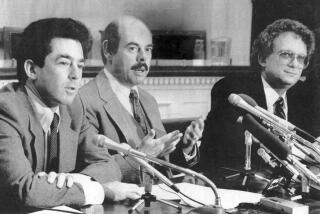Teacher’s Hobby Suits His Subject
- Share via
Of the thousands of political memorabilia collectors in the United States, Neal Machanderof Santa Ana may fit the role best.
A Santa Ana High School history teacher since 1954, Machander has been a collector for nearly 40 years, from the time his uncle, Frank Latham, a one-time Orange County GOP chairman, gave him a box of political items from various candidates.
“I put it aside for a while and then I started to get intrigued with it,” said Machander, a Cal State Long Beach graduate who earned a master’s degree in English literature from UC Irvine.
In the beginning Machander tried to specialize, concentrating on specific candidates and their memorabilia. But later he found more enjoyment collecting and researching many candidates and political parties.
Machander’s vast collection has dwindled somewhat, the result of selling much of it, including valuable items like a 1920 political button for vice presidential candidate Franklin D. Roosevelt, which he bought for $5,000.
“I bought it in 1972 and sold it in 1987 for $20,000. It was sold last year for $49,000,” said Machander, who noted that the one-inch buttons are the only ones with color still available from the campaign. Only five of the estimated 100 Roosevelt buttons were made with color, he said.
The hopes of acquiring a similar treasure drew hordes of collectors to the recent American Political Items Collectors Convention in Anaheim, where a variety of political items were shown.
Machander was chairman of the convention, which has been held every year since 1964. He is also West Coast vice president of the group.
The items included some far-out collectors’ pieces such as a white ceramic hashish pipe made in the likeness of Spiro Agnew and tobacco pipes made from the features of Franklin Roosevelt, John F. Kennedy and Woodrow Wilson.
Machander said that aprons, bedspreads and pillows sold during Richard M. Nixon’s 1972 presidential campaign have become collectors’ items.
“Some of the items are small campaign buttons and the reasoning behind (those) was the candidates didn’t have very much money,” said Machander, an expert on verifying the authenticity of political items.
“There are some people better than I am, but I can tell you one of three things. It’s good, bad or I don’t know,” said Machander, who is often called on to evaluate the worth and authenticity of a collection.
He and three others assessed the authenticity of items at the recent Anaheim convention.
Although he has sold much of his collection, he retains a set of fake political items to compare with authentic items.
At times, he brings some of his items to his government classes.
“The No. 1 use of the collection is for knowledge,” he said. “If you get involved in history and make it a sideline (as a collector) it becomes an intellectual part of you by looking for more information.”
But not all his students are interested.
“Students in class have different thoughts, but I tell them I can’t see how they can understand the United States and its ideals without knowing or having a nodding acquaintance with Thomas Jefferson,” he said.
“I don’t see how anyone can know who they are or where they are without finding out about it,” he added.
More to Read
Sign up for Essential California
The most important California stories and recommendations in your inbox every morning.
You may occasionally receive promotional content from the Los Angeles Times.









